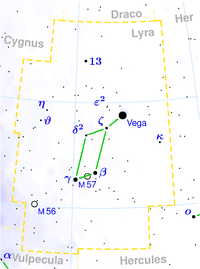Epsilon Lyrae
Epsilon Lyrae (ε Lyr, ε Lyrae), also known as the Double Double,[7] is a multiple star system of at least five stars approximately 162 light-years away in the constellation of Lyra.
 ε (circled) in the constellation Lyra. | |
| Observation data Epoch J2000.0 Equinox J2000.0 | |
|---|---|
| Constellation | Lyra |
| Epsilon1 Lyrae | |
| Right ascension | 18h 44m 20.34589s[1] |
| Declination | +39° 40′ 12.4533″[1] |
| Apparent magnitude (V) | 4.66[2] |
| Epsilon2 Lyrae | |
| Right ascension | 18h 44m 22.78056s[1] |
| Declination | +39° 36′ 45.7851″[1] |
| Apparent magnitude (V) | 4.59[2] |
| Characteristics | |
| ε1 Lyr | |
| Spectral type | A3V + F0V[3] |
| U−B color index | +0.065[2] |
| B−V color index | +0.16[2] |
| ε2 Lyr | |
| Spectral type | A6Vn + A7Vn[3] |
| U−B color index | +0.075[2] |
| B−V color index | +0.18[2] |
| Astrometry | |
| ε1 Lyr | |
| Radial velocity (Rv) | −31.20 ± 1.7[4] km/s |
| Proper motion (μ) | RA: 11.09[1] mas/yr Dec.: 61.39[1] mas/yr |
| Parallax (π) | 20.10 ± 0.76[1] mas |
| Distance | 162 ± 6 ly (50 ± 2 pc) |
| ε2 Lyr | |
| Radial velocity (Rv) | −24.40 ± 1.7[5] km/s |
| Proper motion (μ) | RA: 6.18[1] mas/yr Dec.: 50.42[1] mas/yr |
| Parallax (π) | 20.97 ± 0.50[1] mas |
| Distance | 156 ± 4 ly (48 ± 1 pc) |
| Details | |
| ε1 Lyr A | |
| Mass | 2.03[6] M☉ |
| Luminosity | 24[6] L☉ |
| Temperature | 7,943[6] K |
| Rotational velocity (v sin i) | 165[6] km/s |
| ε1 Lyr B | |
| Mass | 1.61[6] M☉ |
| Luminosity | 8.4[6] L☉ |
| Temperature | 7,047[6] K |
| Rotational velocity (v sin i) | 159[6] km/s |
| ε2 Lyr A | |
| Mass | 2.11[6] M☉ |
| Luminosity | 29[6] L☉ |
| Temperature | 7,816[6] K |
| Rotational velocity (v sin i) | 212[6] km/s |
| ε2 Lyr B | |
| Mass | 2.15[6] M☉ |
| Luminosity | 32[6] L☉ |
| Temperature | 7,852[6] K |
| Rotational velocity (v sin i) | 233[6] km/s |
| Other designations | |
| ε1 Lyr: 4 Lyrae, HIP 91919, BD+39°3509 | |
| ε1 Lyr A: HD 173582, HR 7051, SAO 67310 | |
| ε1 Lyr B: HD 173583, HR 7052, SAO 67309 | |
| Other designations | |
| ε2 Lyr: 5 Lyrae, HIP 91926, BD+39°3510 | |
| ε2 Lyr A: HD 173607, HR 7053, SAO 67315 | |
| ε2 Lyr B: HD 173608, HR 7054 | |
| Database references | |
| ε1 Lyr | |
| ε1 Lyr A | |
| ε1 Lyr B | |
| ε2 Lyr | |
| ε2 Lyr A | |
| ε2 Lyr B | |
Star System

The widest two components of the system are easily separated when viewed through binoculars, or even with the naked eye under excellent conditions.[8]
The northern component is called ε1 (ADS 11635 AB in multiple star notation) and the southern ε2 (ADS 11635 CD); they lie around 160 light years from Earth and orbit each other over hundreds of thousands of years. Their separation of 208″ is about one hundred times that of the subcomponents. When viewed at higher magnifications, each intuitively likely "star" proves to be a set of shorter-term, close-orbiting binary stars. Ability to view these sub-components is a common benchmark for the resolving power of telescopes, since they are so close together: the stars of ε1 were 2.35 arc-seconds apart in 2006, those of ε2 were separated by about the same amount in that year. Since the first high-precision measurements of their orbit in the 1980s, both binaries have moved only a few degrees in position angle.
The component stars of ε1 have magnitudes of 4.7 and 6.2 separated by 2.6" and have an orbital period that can only be crudely estimated at 1200 years, which places them at roughly 140 AU apart. Main components of ε2 have magnitudes 5.1 and 5.5 separated by 2.3", and orbit in perhaps half that period. ε1 and ε2 are more than 0.16 light years apart. An observer at one pair would see the other as strongly as a quarter (also known as half) Moon (which is about mv = −5.0), less than a degree away from each other.[9][10]
The fifth component of this system, orbiting one of the ε2 pair, was detected by speckle interferometry in 1985 and confirmed in two later observations. No orbit can be prepared from such limited data, but its rapid motion suggests a period of a few tens of years. Its maximum observed separation of 0.2 arc-seconds precludes direct visual observation.
A further five nearby dimmer stars are also listed in multiple star catalogues:[11]
| Magnitude | Spectral Type | |
|---|---|---|
| A | 5.15 | A2 |
| B | 6.10 | A4 |
| C | 5.25 | A3 |
| D | 5.38 | A5 |
| E | 11.71 | |
| F | 11.2 | |
| G | 13.83 | |
| H | 13.22 | |
| I | 10.43 | |
| Cb | ? |
| Separation (arcsec) |
Separation (au) |
Most Recent Position Angle |
Period (years) |
Semi-major axis (arcseconds) |
Notes | |
|---|---|---|---|---|---|---|
| AB-CD | 208.2 | 10,500 | 172 | ε1-ε2 | ||
| AB | 2.3 | 116 | 347 | 1804.41 | 4.742 | components of ε1 |
| CD | 2.4 | 121 | 79 | 724.307 | 2.92 | components of ε2 |
| Ca-Cb | 0.1 | 5 | 225 | recently discovered interferometric companion |
References
- van Leeuwen, F.; et al. (2007). "Validation of the new Hipparcos reduction". Astronomy and Astrophysics. 474 (2): 653–664. arXiv:0708.1752. Bibcode:2007A&A...474..653V. doi:10.1051/0004-6361:20078357.
- Mermilliod, J.-C. (1986). "Compilation of Eggen's UBV data, transformed to UBV (unpublished)". Bibcode:1986EgUBV........0M. Cite journal requires
|journal=(help) - Abt, Helmut A.; Morrell, Nidia I. (1995). "The Relation between Rotational Velocities and Spectral Peculiarities among A-Type Stars". Astrophysical Journal Supplement. 95: 135. Bibcode:1995ApJS...99..135A. doi:10.1086/192182.
- Gontcharov, G. A. (2006). "Pulkovo Compilation of Radial Velocities for 35 495 Hipparcos stars in a common system". Astronomy Letters. 32 (11): 759–771. arXiv:1606.08053. Bibcode:2006AstL...32..759G. doi:10.1134/S1063773706110065.
- Kharchenko, N. V.; et al. (2007). "Astrophysical supplements to the ASCC-2.5: Ia. Radial velocities of ~55000 stars and mean radial velocities of 516 Galactic open clusters and associations". Astronomische Nachrichten. 328 (9): 889. arXiv:0705.0878. Bibcode:2007AN....328..889K. doi:10.1002/asna.200710776.
- Zorec, J.; Royer, F. (2012). "Rotational velocities of A-type stars. IV. Evolution of rotational velocities". Astronomy and Astrophysics. 537: A120. arXiv:1201.2052. Bibcode:2012A&A...537A.120Z. doi:10.1051/0004-6361/201117691.
- Dawes, W R (1867). Catalogue of Micrometrical Measurements of Double Stars. Royal Astronomical Society. p. 409.
- Burnham, Robert (1966). Burnham's Celestial Handbook. Dover Publications Inc. pp. 1151–1153. ISBN 0-486-24064-9.
- Jim Kaler. "Epsilon Lyrae". Kaler's Stars. Retrieved 18 November 2013.
- http://observing.skyhound.com/archives/jul/HR_7051.html
- "Washington Double Star Catalog". Archived from the original on 17 May 2011. Retrieved 19 December 2010.
- "Sixth Orbit Catalog". Archived from the original on 12 April 2009. Retrieved 19 December 2010.